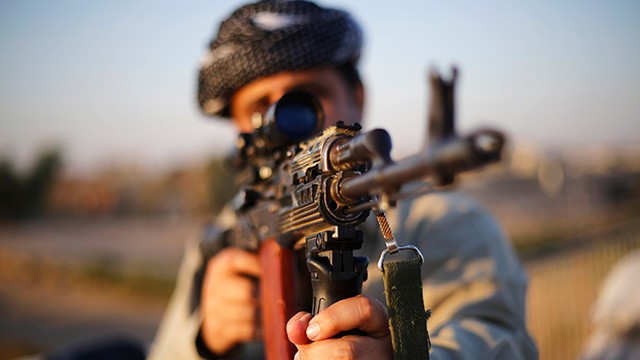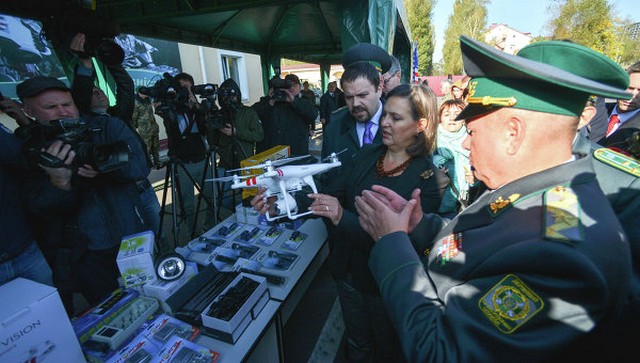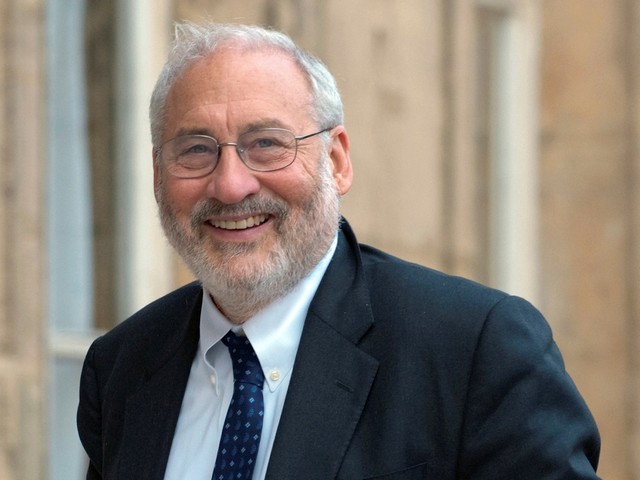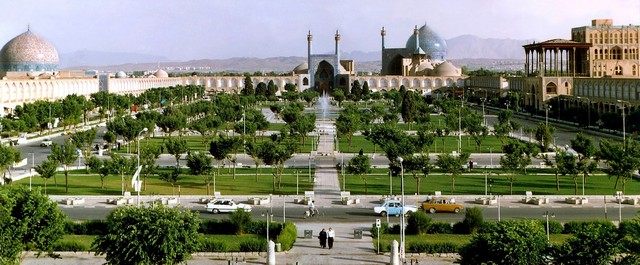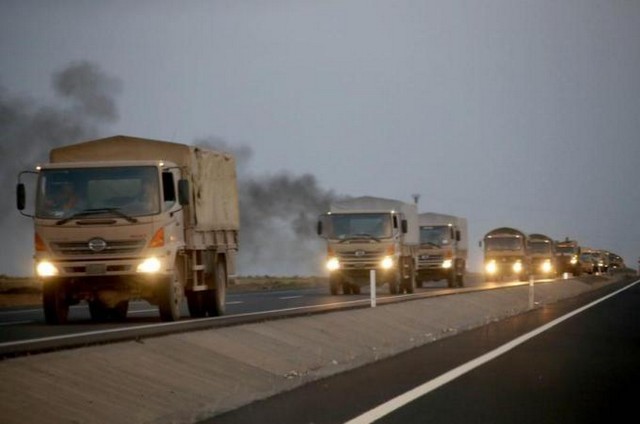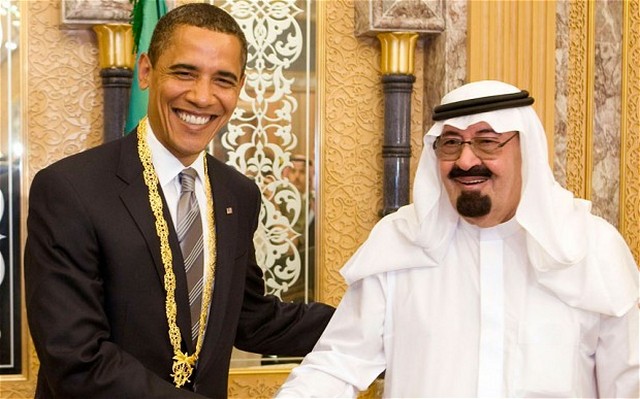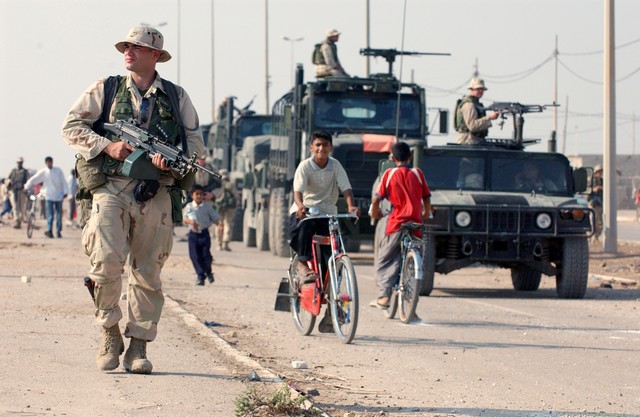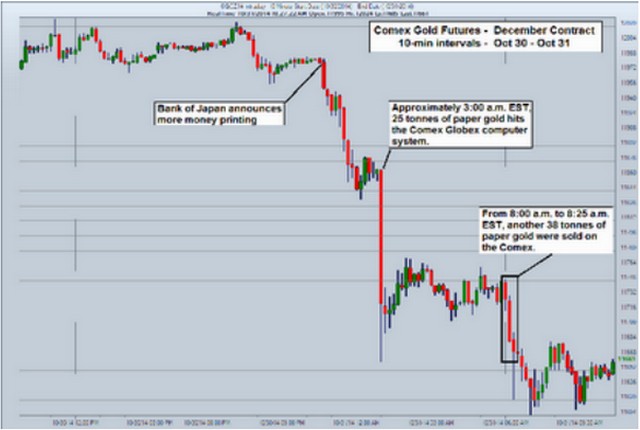What’s Behind Lower Gas-Prices and the Bombings of Syria and of Eastern Ukraine: Obama Represents U.S. & Arabic Aristocracies, Against Those of Russia & Iran
By Eric Zuesse
(The following report reconstructs U.S. President Barack Obama’s foreign policy, on the basis of what I have deemed to be reliable news accounts of his Administration’s actions, not of its mere words. This reconstruction is grounded in the linked-to news-sources, all of which I have investigated and verified — and some of which I wrote. The ones that I wrote are themselves sourced to the links within those reports, all of which I have, likewise, personally checked and verified. Consequently, the chain of verifications back to this reconstruction’s primary sources is available to any online reader, and every reader is encouraged to track back to its ultimate source any allegation that might appear to be at all questionable to him or her in the present article. Not only will this exercise be helpful to the reader concerning that given point at question, but it will open that person to an associated world of deeper discovery, which I hope that this news-report and analysis will do for many readers, and which is the reason I wrote it: so as to share with others what I and other careful and cautious researchers have discovered, though it might be, in some instances, starkly at variance with what our Government, and most of the press, have been more commonly presenting as ‘truth’ about these matters. At least, this exercise will provide an alternative frame of reference regarding these issues, an alternative possibility to consider, and which I have verified, from every root to every branch, in this tree of historical reconstruction of the events.)
INTRODUCTION:
Why is the Ukrainian Government, which the U.S. supports, bombing the pro-Russian residents who live in Ukraine’s own southeast?
Why is the American Government, which aims to oust Syria’s leader Bashar al-Assad, bombing his main enemy, ISIS?
I find that both bombings are different parts of the same Obama-initiated business-operation, in which the American aristocracy, Saudi aristocracy, and Qatari aristocracy, work together, to grab dominance over supplying energy to the world’s biggest energy-market, Europe, away from Russia, which currently is by far Europe’s largest energy-supplier.
Here are the actual percentage-figures on that: Russia supplies 38%, #2 Norway (the only European nation among the top 15) supplies 18%, and all other countries collectively supply a grand total of 44%. That’s it; that’s all — in the world’s largest energy-market. Russia is the lone giant. But U.S. President Obama’s team want to change that. (Unfortunately, the residents in southeastern Ukraine are being bombed and driven out to become refugees in Russia , as an essential part of this operation to choke off Russia’s gas-supply to Europe.)
Obama has initiated, and is leading, this international aristocratic team, consisting of the U.S. aristocracy and Sunni Moslem aristocracies — the Saudi and the Qatari royal families — to choke off Russia’s economic lifeblood from those European energy sales, and to transfer lots of this business, via new oil and gas pipeline contracts and new international trade-deals, over to the royal families of Saudi Arabia and Qatar. Those royals, in turn, are assisting Obama in the overthrow of the key Russia-allied leader of Syria, Bashar al-Assad, who has performed an indispensable role in blocking any such massive expansion of Saudi and Qatari energy-traffic into Europe, and who has thus been a vital protector of Russia’s dominance in the European energy-market.
America’s aristocracy would be benefited in many ways from this changeover to Europe’s increasing dependence upon those Sunni Moslem nations, which have long been allied with U.S. oil companies, and away from the Shiite Moslem nation of Iran, and from its key backer, Russia.
The most important way that America’s aristocrats would benefit would be the continuance, for the indefinite future, of the U.S. dollar’s role as the international reserve currency, in which energy and energy-futures are traded. The Sunni nations are committed to continued dominance of the dollar, and Wall Street depends on that continuance. It’s also one of the reasons the U.S. Treasury’s sales of U.S. Federal debt around the world have been as successful as they are. This also provides essential support to the U.S. Federal Reserve.
Furthermore, Obama’s effort to force the European Union to weaken their anti-global-warming standards so as to allow European imports of oil from the exceptionally carbon-gas-generating Athabasca Canada tar sands — which are approximately 40% owned by America’s Koch brothers, the rest owned by other U.S. and allied oil companies — would likewise reduce Europe’s current dependency upon Russian energy sources, at the same time as it would directly benefit U.S. energy-producers. Obama has been working hard for those oil companies to become enabled to sell such oil into Europe .
And, finally, the extension of U.S. fracking technology into Ukraine, and perhaps ultimately even into some EU nations, where it has been strongly resisted, might likewise reduce the enormous flow of European cash into Russian Government coffers to pay for Russian gas (which doesn’t even require fracking).
In other words, the wars in both Syria and Ukraine are being fought basically in order to grab the European energy market, away from Russia, somewhat in the same way (though far more violently) as Iran’s share of that market was previously grabbed away by means of the U.S.-led sanctions against that country. The current bombing campaigns in both Syria and Ukraine are directed specifically against Iran’s chief ally, Russia.
First, will be discussed here the bombing-campaign against Iran’s and Russia’s ally Assad in Syria; then against the residents of the ethnic-Russian areas of Ukraine.
SYRIA:
As the articles that are headlined below document, there has been proposed, in order to promote Russian gas flowing into Europe, an eastbound Iran-Iraq-Syria-Turkey-Europe gas pipeline (but sanctions stopped that); and there was also proposed, in order to undercut Russian gas flowing into Europe, a northbound Qatar-Saudi-Jordan-Syria-Turkey-Europe gas pipeline — those being two different and competing ways of supplying gas into Europe.
Russia’s ally Syria is crucial to both proposed pipelines, which means that Assad has needed to be overthrown in order for the northbound pipeline from Qatar to be constructed and so to compete against Russia’s gas-supplies to Europe.
There have also been some differences between the Saudi and Qatari royal families as regards their motives for removing the Shiite Assad from leading Syria. Qatar’s royals ( and also Turkey’s aristocrats ) want him to be replaced by an anti-Iranian, Sunni Moslem Brotherhood leader (the type of person that Obama euphemistically calls by such terms as ‘moderate Moslems’ though they were hardly that in Egypt once they gained power there ). Qatar’s royals have protected themselves from being overthrown by fundamentalist Moslems; they’ve done it especially by supporting the Moslem Brotherhood as a means of displaying their own loyalty to Moslem clerics. (The public trusts the clerics, but doesn’t trust the aristocrats; and, like everywhere, aristocrats obtain their perceived ‘legitimacy’ from the local clergy, whom aristocrats buy-off with special favors.) The Moslem Brotherhood want to control Syria, and would love to approve a gas pipeline from Qatar through Syria to Europe, to reward their chief benefactor, Qatar’s royals. As for the Saudi royals, they want Assad to be replaced by an anti-Iranian, Sunni ISIS leader, who will represent the Sauds’ Wahhabist sect in Islam, which provides Saudi royals their ‘legitimacy.’ (Saudi royals say they don’t like Al Qaeda and ISIS, but that’s said mainly for public consumption in the West.) Right now, Saudi Arabia supplies less than 5% of Europe’s energy, which is a mere one-eighth of what Russia does. So: each of these two royal families relies primarily upon a different category of Islamists. Obama prefers the ‘moderate’ Muslim Brotherhood to the extremist ISIS, but Saudi royals accept his having that preference, because any way to weaken Iran and its backer Russia is fine with them, especially since it would open wide the enormous European market for their oil.
Other internal conflicts also exist within Obama’s team. For example, an expert on these matters, Felix Imonti, explained to me in a personal communication, that, “Qatar … abandoned the [pipeline] plan in 2010 for a very simple reason. Saudi Arabia will not permit a pipeline to be constructed across its territory. Qatar is interested along with Turkey in installing a MB government in Syria. … The Saudi objective is to drive out the Iranians from Syria.” The Saudis’ “objective was to establish a Wahhabi based [fundamentalist Moslem] state that would include western Iraq with Syria,” which, of course, is what ISIS is all about. Imonti also says: “Egypt [except for the brief time when it was controlled by the MB] is a bought puppet of Saudi Arabia. The Egyptians are bombing Qatari groups in Libya.” That Egyptian action is indirectly a Saudi attack against the Qatari royals’ own support-base. These issues between the two royal families are like squabbles within a family: more is shared in common than splits them apart. Obama’s decisions are often determinative on such matters.
So, America’s aristocracy supports both the Saudi and the Qatari aristocracies, despite their disagreements, in order to defeat the aristocracies in Russia, China, and the other “BRIC” countries.
Or, as President Obama’s speech at West Point, on 28 May 2014 , propagandized for this view on the part of America’s aristocracy: “Russia’s aggression toward former Soviet states unnerves capitals in Europe, while China’s economic rise and military reach worries its neighbors. From Brazil to India, rising middle classes compete with us.” So, Obama made clear to the graduating cadets that the BRIC countries are the enemy, from the standpoint of America’s aristocracy. Ours want to crush the aristocrats in Brazil, Russia, India, and China. Though it’s alright for those other countries to produce more, that’s true only if American aristocrats control the local ones, like in any other international empire — not if the local aristocrats there do. Similarly, for example, the British Empire didn’t wish for local aristocrats in India to be in control, but only for those client aristocrats to be of use . Obama added, placing a nationalistic coloration on his promotion of America’s empire: “The United States is and remains the one indispensable nation.” He promised to keep it that way: “That has been true for the century passed [sp.: past [[somebody at the White House didn’t know the difference between ‘past’ and ‘passed’]] and it will be true for the century to come.”
An important asset of the American aristocracy happens to be shale-gas-fracking technology, which is overwhelmingly owned by America’s aristocrats . Though Qatar is a major gas-producer, it has no need for fracking, and so is merely a gas-competitor in that regard, but they do share America’s pro-Sunni, anti-Assad goal, and also America’s anti-Russian goal. Although Qatar ships most of its gas into Asia, they’d like to have some way to pipe it more nearby, into Europe, to undercut Russia’s Gazprom. And that’s why the U.S. is working with Qatar to bump Assad from Syria.
The Saudis are actually doing the most of all to defeat Russia, by driving oil prices down so low as to upset Russia’s economic plans, which have been based upon minimum $100/barrel projections. We’re already around 10% below that. As Imonti writes, “The Saudis can sustain these lower prices for seven or eight years while drawing on their foreign reserves to cover the deficits. They could very well be trying to break the fracking business in the U.S. that has high production costs. [Of course, America’s gas aristocrats won’t like that, but Obama has to balance multiple sub-constituencies, including Qatar’s royals.] They might also be directing the target towards Russia that supports Assad and Iran. They could be doing all of the above with one action.” If the Sauds keep this up “for seven or eight years,” then Russia will be hit a lot harder than Russia is being hit, or is likely to be hit, by any economic sanctions.
Qatar has been the main funder of the overthrow-Assad movement, for the Moslem Brotherhood; and Saudi Arabia has been the main funder of the overthrow-Assad movement, for ISIS. Both are Sunni organizations. However, Qatar has also funded ISIS. Obama, when he decided to bomb ISIS, was acting on behalf of America’s aristocrats, but Saudi and Qatari aristocrats might have felt differently about it. He possessed the freedom to do this, which those aristocrats don’t have, because everyone in the Islamic world knows that Obama is no Moslem; everyone understands that America is in a permanent state of war against fundamentalist Islam of all sorts. Only Moslem aristocrats need the approval of Islamic fundamentalists. In America, aristocrats don’t even need the approval of Christian fundamentalists, the type of fundamentalists that might be able to threaten their authority in the West (since the West is predominantly Christian, not Moslem). And the same is true regarding Jewish aristocrats in Israel: aristocrats fear only their local majority clergy. That’s basic survival-knowledge for aristocrats, anywhere, in order to be able to get the public to accept the rightfulness of the aristocracy itself there.
So, ISIS gets money from the aristocracies of Saud, and of Qatar (and also, more recently, of Kuwait) — whatever is needed, in order for those aristocrats to retain the loyalty of their local clerics, and thus their public. It’s like aristocrats do in every country, getting “God’s approval” of their wealth, by throwing a few coins to the preacher, the local mouthpiece for “God,” thus relying upon the public’s trust in clergy. Even Mafia aristocrats do it. That has been the way of conservatism for millennia; it’s the way conservatism works. In more-recent centuries, a modified version of that trick has grown up, as liberalism, in which the aristocrats’ validation comes instead from scholars, and so aristocrats throw a few coins to them, instead of to clerics. But it’s no different — it’s authoritarianism, equally in either case. It’s purchased authority. Aristocrats don’t really fear the clergy, nor the scholars: they actually fear the public, such as what happened during the French Revolution, and during the Russian Revolution. But that’s another story altogether, going back millennia, actually.
The recent bombings in Syria, and in Ukraine, are a business-operation being carried out as a war (and also very profitable for U.S. armaments-makers, who likewise are controlled by America’s aristocrats and so this is a double-whammy for America’s aristocracy — and U.S. arms-makers have consequently been soaring on the stock market). It’s basically a grab by U.S. and Sunni aristocrats, from Russian and Shiite aristocrats, of the market to supply oil and gas into Europe. And it provides other advantages, too, for U.S. aristocrats.
Natural gas, especially of the non-fracked variety, is generally regarded as the bridge-fuel to get our planet to being able to survive long-term while fusion and renewable forms of energy come online as cost-competitive. Fracking is, as has been mentioned, an American technology, but it’s widely resisted even within American-allied nations. The U.S. Government can impose it upon the American people, because they are trusting in ‘free enterprise,’ but other governments are having a hard time trying to impose it on theirs. That public resistance in Europe is giving protection to the gas-import markets there; and this has benefited Russia, their major existing gas-supplier.
Russia has the world’s largest proven reserves of natural gas , and that’s without their even needing to use fracking-techniques in order to get at it. #2 Iran has 69% as much gas, and is allied with Russia, and it also doesn’t frack. But sanctions close them out of Europe. Then #3 Qatar, at 47%, is allied with U.S. oil companies, but has no need to frack. Then #4 Turkmenistan, 37%, is allied with Russia, and also doesn’t frack. Then #5 U.S., 20%, is allied with U.S. oil companies, and only fracks. Then #6 Saudi Arabia, 17%, is also allied with U.S. oil companies, and doesn’t need to frack.
The European Union bans fracking, because they have environmentally-concerned publics. But U.S. and other Western corporate-owned oil companies want to frack gas in Europe, just as they do in America; and the new Ukrainian Government is desperate enough to want their land to be fracked.
UKRAINE:
The main shale-gas (fracking) field in Ukraine is Yuzivska, right in the middle of the Donbass region, where the residents don’t want fracking and don’t want U.S. rule (which includes fracking). Furthermore, the people there reject the legitimacy of the Obama coup in Ukraine this year in February , and of its subsequent rulers of Ukraine , who have been bombing them , because 90% of the voters in that region had voted for the pro-Russian President whom Obama had overthrown , and because the new, anti-Russian, regime doesn’t want those people to stay (or at least to stay alive ) in Ukraine, because otherwise that post-coup regime would become ousted if any nationwide election would ever again be held throughout Ukraine. This tactic of killing unwanted voters is a variant of what the Republican Party does in the U.S., simply trimming the voter-rolls in order to create a more-favorable “voting public.” Except that it’s being done in Ukraine by bombs and bullets , rather than by limiting or restricting ballots.
“The West,” or the allies of Sunni aristocrats, are now bombing intensively, both in Ukraine and in Syria; and, in both instances, the argument for the bombings is to spread “democracy” there. It’s giving a bad name to ‘democracy,’ to anyone who misbelieves that this is it.
BACK AGAIN TO SYRIA:
Below are the main sources that describe the Middle Eastern part of this Obama-Putin power-struggle, that is the part in Syria instead of in Ukraine. This is how international business is actually carried out – it’s a perfect libertarian world, since there is no international government; this market is unregulated to so extreme an extent that even ethnic cleansings and mass-murders go unpunished — it’s a pure free market, which operates on an international scale (the only scale where libertarianism exists in even nearly this pure a form); this libertarianism is an exemplar of the conservative ideal: pure liberty for aristocrats, total lack of accountability . If anything, Barack Obama might be even more of a conservative than was George W. Bush: under Obama, the IRS specifically allows blatantly illegal tax-evasion by the mega-rich to go uninvestigated and unpunished, and concentrates virtually all its resources on pursuing two-bit tax-cheats. That’s what ‘democracy’ has come to in America. In America’s client-states, such as in the Middle East and (since February) in Ukraine, it’s even worse.
The first of these articles explains why the price of oil has been plunging, and who has been behind that:
—
http://www.boilingfrogspost.com/2014/10/24/the-secret-stupid-saudi-us-deal-on-syria/
“The Secret Stupid Saudi-US Deal on Syria”
WILLIAM ENGDAHL | OCTOBER 24, 20143 COMMENTS
The Kerry-Abdullah Secret Deal & An Oil-Gas Pipeline War
—
http://www.zerohedge.com/news/2014-10-10/why-oil-plunging-other-part-secret-deal-between-us-and-saudi-arabia
“Why Oil Is Plunging: The Other Part Of The “Secret Deal” Between The US And Saudi Arabia”
Tyler Durden on 10/11/2014 18:19 -0400
… [Excerpt:] Today’s Brent closing price: $90. Russia’s oil price budget for the period 2015-2017? $100. Which means much more “forced Brent liquidation” is in the cards in the coming weeks as America’s suddenly once again very strategic ally, Saudi Arabia, does everything in its power to break Putin. [Note: The Russian Government’s fiscal projections were based on $100/barrel, but the Saudi-forced-down price was now $89/barrel. How long would Saudis and Qataris keep this up? And how long would Assad hold off ISIS? Big bets are being made on both.]
—
http://www.zerohedge.com/news/2014-09-25/look-inside-secret-deal-saudi-arabia-unleashed-syrian-bombing
“A Look Inside The Secret Deal With Saudi Arabia That Unleashed The Syrian Bombing”
Tyler Durden on 09/25/2014 10:17 -0400
… [Excerpt:] Said otherwise, the pound of flesh demanded by Saudi Arabia to “bless” US airstrikes and make them appear as an act of some coalition, is the removal of the Assad regime. Why? So that, as we also explained last year, the holdings of the great Qatar natural gas fields can finally make their way onward to Europe, which incidentally is also America’s desire — what better way to punish Putin for his recent actions than by crushing the main leverage the Kremlin has over Europe?
—
http://www.zerohedge.com/news/2013-08-27/meet-saudi-arabias-bandar-bin-sultan-puppetmaster-behind-syrian-war
” Meet Saudi Arabia’s Bandar bin Sultan: The Puppetmaster Behind The Syrian War”
Tyler Durden on 08/27/2013 15:21 -0400
… [Excerpt:] Of course, there is Syria:
Regarding the Syrian issue, the Russian president responded to Bandar, saying, “Our stance on Assad will never change. We believe that the Syrian regime is the best speaker on behalf of the Syrian people, and not those liver eaters. During the Geneva I Conference, we agreed with the Americans on a package of understandings, and they agreed that the Syrian regime will be part of any settlement. Later on, they decided to renege on Geneva I. In all meetings of Russian and American experts, we reiterated our position. In his upcoming meeting with his American counterpart John Kerry, Russian Foreign Minister Sergey Lavrov will stress the importance of making every possible effort to rapidly reach a political settlement to the Syrian crisis so as to prevent further bloodshed.”
Alas, that has failed.
So what are some of the stunning disclosures by the Saudis?
Bandar told Putin, “There are many common values and goals that bring us together, most notably the fight against terrorism and extremism all over the world. Russia, the US, the EU and the Saudis agree on promoting and consolidating international peace and security. The terrorist threat is growing in light of the phenomena spawned by the Arab Spring. We have lost some regimes. And what we got in return were terrorist experiences, as evidenced by the experience of the Muslim Brotherhood in Egypt and the extremist groups in Libya. … As an example, I can give you a guarantee to protect the Winter Olympics in the city of Sochi on the Black Sea next year. The Chechen groups that threaten the security of the games are controlled by us, and they will not move in the Syrian territory’s direction without coordinating with us. These groups do not scare us. We use them in the face of the Syrian regime but they will have no role or influence in Syria’s political future.”
—
http://www.zerohedge.com/news/2013-08-08/putin-laughs-saudi-offer-betray-syria-exchange-huge-arms-deal
“Putin Laughs At Saudi Offer To Betray Syria In Exchange For ‘Huge’ Arms Deal”
Tyler Durden on 08/08/2013 11:20 -0400
—
http://www.zerohedge.com/news/2013-05-16/mystery-sponsor-weapons-and-money-syrian-rebels-revealed
“Mystery Sponsor Of Weapons And Money To Syrian Mercenary ‘Rebels’ Revealed”
Tyler Durden on 05/16/2013 19:12 -0400
… [Excerpt:] So there you have it: Qatar doing everything it can to promote bloodshed, death and destruction by using not Syrian rebels, but mercenaries: professional citizens who are paid handsomely to fight and kill members of the elected regime (unpopular as it may be), for what? So that the unimaginably rich emirs of Qatar can get even richer. Although it is not as if Russia is blameless: all it wants is to preserve its own strategic leverage over Europe by being the biggest external provider of natgas to the continent through its own pipelines. Should Nabucco come into existence, Gazpromia would be very, very angry and make far less money!
—
The final source will be posted here in full, because it goes closest to the reason for our bombing Syria:
http://oilprice.com/Energy/Energy-General/Qatar-Rich-and-Dangerous.html
“Qatar: Rich and Dangerous”
17 September 2012, by Felix Imonti
The first concern of the Emir of Qatar is the prosperity and security of the tiny kingdom. To achieve that, he knows no limits.
Stuck between Iran and Saudi Arabia is Qatar with the third largest natural gas deposit in the world. The gas gives the nearly quarter of a million Qatari citizens the highest per capita income on the planet and provides 70 percent of government revenue.
How does an extremely wealthy midget with two potentially dangerous neighbors keep them from making an unwelcomed visit? Naturally, you have someone bigger and tougher to protect you.
Of course, nothing is free. The price has been to allow the United States to have two military bases in a strategic location. According to Wikileaks diplomatic cables, the Qataris are even paying sixty percent of the costs.
Having tanks and bunker busting bombs nearby will discourage military aggression, but it does nothing to curb the social tumult that has been bubbling for decades in the Middle Eastern societies. Eighty-four years ago, the Moslem Brotherhood arose in Egypt because of the presence of foreign domination by Great Britain and the discontent of millions of the teaming masses yearning to be free. Eighty-four years later, the teaming masses are still yearning.
Sixty-five percent of the people in the Middle East are under twenty-nine years of age. It is this desperate angry group that presents a danger that armies cannot stop. The cry for their dignity, “I am a man,” is the sound that sends terror through governments. It is this overwhelming force that the Emir of Qatar has been able to deflect.
A year after he deposed his father in 1995, Sheikh Hamad bin Khalifa Al-Thani established the Al-Jazeera television satellite news network. He invited some of the radical Salafi preachers that had been given sanctuary in Qatar to address the one and a half billion Moslems around the world. They had their electronic soapbox and the card to an ATM, but there was a price.
The price was silence. They could speak to the world and arouse the fury in Egypt or Libya, but they would have to leave their revolution outside of Qatar or the microphone would be switched off and the ATM would stop dispensing the good life.
The Moslem Brotherhood, that is a major force across the region, dissolved itself in Qatar in 1999. Jasim Sultan, a member of the former organization, explained that the kingdom was in compliance with Islamic law. He heads the state funded Awaken Project that publishes moderate political and philosophical literature.
How Qatar has benefited from networking with the Salafis is illustrated by the connections with Tunisia where Qatar is making a large investment in telecommunications. Tunisian Foreign Minister Rafiq Abdulsalaam was head of the Research and Studies Division in the Al Jazeera Centre in Doha. His father-in-law Al Ghanouchi is the head of the Tunisian Moslem Brotherhood party.
Over much of the time since he seized power, Sheikh Hamad bin Khalifa Al-Thani has followed the policy of personal networking, being proactive in business and neutral on the international stage. The Emir is generous with the grateful, the Qatar Sovereign Wealth Fund bargains hard in the board room and the kingdom makes available Qatar’s Good Offices to resolve disputes.
Qatar’s foreign policy made an abrupt shift when the kingdom entered the war against Qaddafi. The kingdom sent aircraft to join NATO forces. On the ground, Qatari special forces armed, trained, and led Libyans against Qaddafi’s troops.
The head of the National Transition Council Mustafa Abdul Jalil attributed much of the success of the revolution to the efforts of Qatar that he said had spent two billion dollars. He commented, “Nobody traveled to Qatar without being given a sum of money by the government.”
Qatar had ten billion dollars in investments in Libya to protect. The Barwa Real Estate Company alone had two billion committed to the construction of a beach resort near Tripoli.
While the bullets were still flying, Qatar signed eight billion dollars in agreements with the NTC. Just in case things with the NTC didn’t work out, they financed rivals Abdel Hakim Belhaj, leader of the February 17 Martyr’s Brigade, and Sheik Ali Salabi, a radical cleric who had been exiled in Doha.
If Qatar’s investments of ten billion dollars seem substantial, the future has far more to offer. Reconstruction costs are estimated at seven hundred billion dollars. The Chinese and Russians had left behind between them thirty billion in incomplete contracts and investments and all of it is there for the taking for those who aided the revolution.
No sooner had Qaddafi been caught and shot, Qatar approached Bashar Al-Assad to establish a transitional government with the Moslem Brotherhood. As you would expect, relinquishing power to the Brotherhood was an offer that he could refuse. It didn’t take long before he heard his sentence pronounced in January 2012 on the CBS television program, 60 Minutes by Sheikh Hamad bin Khalifa Al-Thani.
The Emir declared that foreign troops should be sent into Syria. At the Friends of Syria conference in February, Prime Minister Hamad bin Jassim al-Thani said, “We should do whatever necessary to help [the Syrian opposition], including giving them weapons to defend themselves.”
Why would Qatar want to become involved in Syria where they have little invested? A map reveals that the kingdom is a geographic prisoner in a small enclave on the Persian Gulf coast.
It relies upon the export of LNG, because it is restricted by Saudi Arabia from building pipelines to distant markets. In 2009, the proposal of a pipeline to Europe through Saudi Arabia and Turkey to the Nabucco pipeline was considered, but Saudi Arabia that is angered by its smaller and much louder brother has blocked any overland expansion.
Already the largest LNG producer, Qatar will not increase the production of LNG. The market is becoming glutted with eight new facilities in Australia coming online between 2014 and 2020.
A saturated North American gas market and a far more competitive Asian market leaves only Europe. The discovery in 2009 of a new gas field near Israel, Lebanon, Cyprus, and Syria opened new possibilities to bypass the Saudi Barrier and to secure a new source of income. Pipelines are in place already in Turkey to receive the gas. Only Al-Assad is in the way.
Qatar along with the Turks would like to remove Al-Assad and install the Syrian chapter of the Moslem Brotherhood. It is the best organized political movement in the chaotic society and can block Saudi Arabia’s efforts to install a more fanatical Wahhabi based regime. Once the Brotherhood is in power, the Emir’s broad connections with Brotherhood groups throughout the region should make it easy for him to find a friendly ear and an open hand in Damascus.
A control centre has been established in the Turkish city of Adana near the Syrian border to direct the rebels against Al-Assad. Saudi Deputy Foreign Minister Prince Abdulaziz bin Abdullah al-Saud asked to have the Turks establish a joint Turkish, Saudi, Qatari operations center. “The Turks liked the idea of having the base in Adana so that they could supervise its operations” a source in the Gulf told Reuters.
The fighting is likely to continue for many more months, but Qatar is in for the long term. At the end, there will be contracts for the massive reconstruction and there will be the development of the gas fields. In any case, Al-Assad must go. There is nothing personal; it is strictly business to preserve the future tranquility and well-being of Qatar.
—
I wish to express my appreciation to Mr. Imonti for his allowing me to publish here the entirety of that article.
———-
Investigative historian Eric Zuesse is the author, most recently, of They’re Not Even Close: The Democratic vs. Republican Economic Records, 1910-2010 , and of CHRIST’S VENTRILOQUISTS: The Event that Created Christianity .
06 November, 2014
Countercurrents.org

